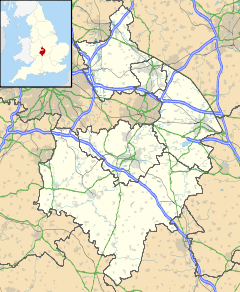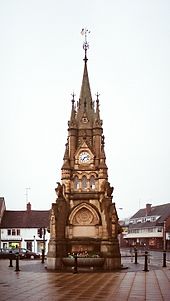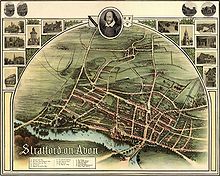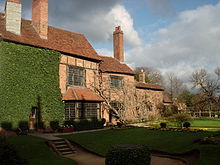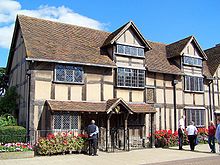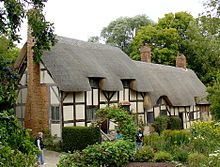
Stratford-upon-Avon
About this schools Wikipedia selection
This content from Wikipedia has been selected by SOS Children for suitability in schools around the world. SOS Child sponsorship is cool!
Coordinates: 52.19°N 1.710°W
| Stratford-upon-Avon | |
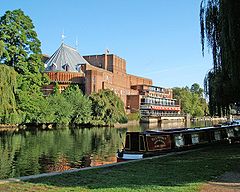 The Royal Shakespeare Theatre alongside the River Avon |
|
|
|
|
| Population | 25,505 (2007 ONS estimate) |
|---|---|
| OS grid reference | SP1955 |
| District | Stratford-on-Avon |
| Shire county | Warwickshire |
| Region | West Midlands |
| Country | England |
| Sovereign state | United Kingdom |
| Post town | STRATFORD-UPON-AVON |
| Postcode district | CV37 |
| Dialling code | 01789 |
| Police | Warwickshire |
| Fire | Warwickshire |
| Ambulance | West Midlands |
| EU Parliament | West Midlands |
| UK Parliament | Stratford-on-Avon |
|
|
Stratford-upon-Avon (pron.: / ˌ s t r æ t f ə d ə p ɒ n ˈ eɪ v ən /, known locally as Stratford) is a market town and civil parish in south Warwickshire, England. It lies on the River Avon, 22 miles (35 km) south east of Birmingham and 8 miles (13 km) south west of Warwick. It is the largest and most populous town of the District of Stratford-on-Avon, which uses the term "on" to indicate that it covers a much larger area than the town itself. Four electoral wards make up the urban town of Stratford; Alveston, Avenue and New Town, Mount Pleasant and Guild and Hathaway. The estimated total population for those wards in 2007 was 25,505.
The town is a popular tourist destination owing to its status as birthplace of the playwright and poet William Shakespeare, receiving about three million visitors a year from all over the world. The Royal Shakespeare Company resides in Stratford's Royal Shakespeare Theatre, one of Britain's most important cultural venues.
History
Stratford has Anglo-Saxon origins, and grew up as a market town in medieval times. The original charters of the town were granted in 1196, making Stratford officially over 800 years old. The name is a fusion of the Old English strǣt, meaning "street", and ford, meaning that a Roman road forded the River Avon at the site of the town.
In 1769 the actor David Garrick staged a major Shakespeare Jubilee which saw the construction of a large rotunda and the influx of many visitors for the three day event. This contributed to the growing phenomenon of Bardolatry which made Stratford a tourist destination.
Governance
The administrative body for the town is the Stratford-upon-Avon Town Council, which is based at the Town Hall in Rother Street. The Stratford-on-Avon District Council is based at Elizabeth House, Church Street, and the Stratford-upon-Avon Town Trust is based in the Civic Hall, Rother Street. The Town Council is responsible for crime prevention, cemeteries, public conveniences, litter, river moorings, parks, grants via the Town Trust and the selection of the town's mayor.
Geography
Stratford is close to the Cotswolds, with Chipping Campden 10 miles (16 km) to the south. The Cotswolds where a major sheep producing area, up until the later part of the 19th century, regarded Stratford as one of its main centres for the slaughter, marketing, and distribution of sheep and wool. As a consequence Stratford also became a centre for tanning during the 15th–17th centuries. Both the river and the Roman road served as trade routes for the town.
Suburbs and areas of Stratford-on-Avon include Shottery, Bishopton, Bridgetown, Tiddington, and Old Town.
 |
Redditch, Birmingham | Sutton Coldfield, Solihull | Warwick, Coventry |  |
| Alcester, Worcester, Droitwich | Southam, Daventry | |||
| Evesham, Tewkesbury, Gloucester | Chipping Norton, Witney, Cirencester, Swindon | London, Oxford, Banbury, Reading |
Climate
Stratford experiences a temperate maritime climate, as is usual for the British Isles, meaning extreme heat, or extreme cold are rare, sunshine is on the low side, and rainfall is spread evenly throughout the year.
The record high temperature is 35.7 °C (96.3 °F), set in August 1990, compared to the typical summer maximum of 22 °C (72 °F). The record low temperature is −21.0 °C (−5.8 °F), recorded in January 1982. With an average of 62 frosts a year, Stratford is a relatively frosty location. For comparison, nearby Wellesbourne averages 53 frosts a year, and further afield, Malvern, just 33.
Sunshine, at under 1,400 hours a year, is on the low side. Like much of inland Britain, Stratford is afflicted by cloud development on many days, while more coastal areas remain clear. An example of this is shown in the image to the right.
Rainfall, at around 620 mm is typical for low lying areas of central and eastern England. Over 1 mm of rain was recorded on 115.7 days per year, according to the 1971–2000 observation period.
| Climate data for Stratford-upon-Avon, elevation 49m, 1971–2000 | |||||||||||||
|---|---|---|---|---|---|---|---|---|---|---|---|---|---|
| Month | Jan | Feb | Mar | Apr | May | Jun | Jul | Aug | Sep | Oct | Nov | Dec | Year |
| Average high °C (°F) | 6.9 (44.4) |
7.5 (45.5) |
10.2 (50.4) |
12.8 (55) |
16.5 (61.7) |
19.4 (66.9) |
22.2 (72) |
21.7 (71.1) |
18.5 (65.3) |
14.3 (57.7) |
9.9 (49.8) |
7.7 (45.9) |
14.0 (57.2) |
| Average low °C (°F) | 0.7 (33.3) |
0.5 (32.9) |
2.0 (35.6) |
3.2 (37.8) |
5.8 (42.4) |
8.8 (47.8) |
10.9 (51.6) |
10.7 (51.3) |
8.7 (47.7) |
6.0 (42.8) |
2.8 (37) |
1.5 (34.7) |
5.2 (41.4) |
| Precipitation mm (inches) | 55.6 (2.189) |
40.6 (1.598) |
45.6 (1.795) |
46.5 (1.831) |
48.8 (1.921) |
55.3 (2.177) |
44.0 (1.732) |
61.1 (2.406) |
55.0 (2.165) |
56.2 (2.213) |
52.0 (2.047) |
61.4 (2.417) |
622.3 (24.5) |
| Mean monthly sunshine hours | 48.7 | 61.3 | 95.2 | 132.0 | 177.0 | 167.1 | 189.4 | 177.9 | 129.6 | 98.0 | 60.6 | 42.5 | 1,379.2 |
| Source: Met Office | |||||||||||||
Economy
Apart from tourism, which is a major employer locally, especially in the hotel, hospitality industry and catering sectors, other industries in the town are boat building and maintenance, bicycles, mechanical and electrical engineering, food manufacture, Information Technology, call centre and service sector activities, a large motor sales sector, industrial plant hire, building suppliers, market gardening, farming, storage and transport logistics, finance and insurance, and a large retail sector.
Major employers in the town include the NFU Mutual Insurance Company (and Avon Insurance), AMEC, Tesco, Morrisons, Marks & Spencer, Debenhams, B & Q and Pashley Cycles. There are, nominally, three theatres run by the prestigious Royal Shakespeare Company, which attract large audiences and income for the town.
Tourism
The regular large influx of tourists and sightseers is recognised by most of the town's business operators as being the major source of prosperity. The District Council in 2010 allocated a budget of £298,000 to tourist promotion and supports an official open-top tour bus service. However, in March 2010, the District Council withdrew funding of the Tourist Information Centre, causing it and its parent company; South Warwickshire Tourism Ltd to cease trading. The operation had been jointly funded by the Warwick District Council. Negotiations for the appointment of a liquidator were expected to clear the way for a restructured service. In November 2010 Stratford-on-Avon District Council launched a re-branded official tourism website for the Stratford area called Discover Stratford after opening a new tourist information centre on Henley Street in May 2010, which has since moved back to the original location on Bridgefoot.
Main sights
Theatre
The first real theatre in Stratford was a temporary wooden affair built in 1769 by the actor David Garrick for his Shakespeare Jubilee celebrations of that year to mark Shakespeare's birthday. The theatre, built not far from the site of the present Royal Shakespeare Theatre, was almost washed away in two days of torrential rain that resulted in terrible flooding.
A small theatre known as the Royal Shakespeare Rooms was built in the gardens of Shakespeare's New Place home in the early 19th century but became derelict by the 1860s.
To celebrate the 300th anniversary of Shakespeare's birth in 1864 the brewer, Charles Edward Flower, instigated the building of a temporary wooden theatre, known as the Tercentenary Theatre, which was built in a part of the brewer's large gardens on what is today the site of the new, and temporary, Courtyard Theatre. After three months the Tercentenary Theatre was dismantled, with the timber used for house-building purposes.
In the early 1870s, Charles Flower gave several acres of riverside land to the local council on the understanding that a permanent theatre be built in honour of Shakespeare's memory, and by 1879 the first Shakespeare Memorial Theatre had been completed. It proved to be a huge success, and by the early 20th century was effectively being run by the actor/manager Frank Benson, later Sir Frank Benson.
The theatre burned down in 1926, with the then artistic director, William Bridges-Adams, moving all productions to the local cinema.
An architectural competition was arranged to elicit designs for a new theatre, with the winner, English architect Elisabeth Scott, creating what we see on the riverside today. The new theatre, adjoining what was left of the old theatre, was opened by the then Prince of Wales, later Edward VIII, in 1932.
The new theatre had many illustrious artistic directors, including the actor Anthony Quayle.
Sir Peter Hall was appointed artistic director (designate) in 1959, and formed the Royal Shakespeare Company (RSC) in 1961.
Swan Theatre was created in the 1980s out of the shell of the remains of the original Memorial Theatre, quickly becoming one of the finest acting spaces in the UK.
In 1986, Stratford-upon-Avon became home to the legendary but ill-fated Carrie.
The Waterside Theatre (which is not part of the Royal Shakespeare Theatre complex) re-opened in December 2004, then closed again in September 2008. During this span, the theatre housed the Shakespearience visitor attraction.
The town is located on the River Avon (afon or avon being a Celtic synonym of "river"), on a bank of which stands the Royal Shakespeare Theatre (RST) designed by the English architect Elisabeth Scott and completed in 1932, which is the home of the Royal Shakespeare Company. Until recently the RSC also ran two smaller theatres, the Swan, which is modelled on an Elizabethan theatre (closed in August 2007 as part of plans for refurbishment) and The Other Place theatre, a Black box theatre which was extended to become the temporary RSC Courtyard Theatre, which opened in July 2006. This theatre was the home of the RSC while the RST was being refurbished; its interior is similar to the interior of the refurbished RST. The RST and Swan refurbishment has been completed and the RST and Swan theatres re-opened in November 2010. It is anticipated that the Courtyard Theatre extension may be dismantled, although many in the town would retain the Courtyard so that it can used by local theatre companies.
Other tourist attractions within the town include five houses relating to Shakespeare's life, which are owned and cared for by the Shakespeare Birthplace Trust. These include Hall's Croft (the one-time home of Shakespeare's daughter, Susanna, and her husband Dr. John Hall) and Nash's House, which stands alongside the site of another property, New Place, owned by Shakespeare himself, wherein he died. Near to the town are Anne Hathaway's Cottage at Shottery, the home of Shakespeare's wife's family prior to her marriage, and Mary Arden's House ( Palmer's Farm), the family home of his mother. Elsewhere in the district are farms and buildings at Snitterfield, that belonged to the family of Shakespeare's father.
At the top end of Waterside is Holy Trinity Church, where Shakespeare was baptised and is buried.
Non-Shakespearean attractions include the Stratford Butterfly Farm, which is on the eastern side of the river and the Bancroft Gardens and Stratford Armouries located three miles from the centre of Stratford on Gospel Oak Lane.
Each year on 12 October (unless this is a Sunday, in which case 11 October) Stratford hosts one of the largest Mop Fairs in the country. Then, on the second Saturday following, the smaller Runaway Mop fair is held.
Henley Street
Henley Street, one of the town's oldest streets, underwent substantial architectural change between the sixteenth and nineteenth centuries. John Shakespeare's large half-timbered dwelling, purchased by him in 1556, was in 1564 the birthplace of his son William. According to a descriptive placard provided for tourists there,
"The property remained in the ownership of Shakespeare's direct descendants until 1670, when his granddaughter, Elizabeth Barnard, died. As she had no children, Elizabeth left the estate to her relative Thomas Hart, Shakespeare's great-nephew. The main house became a tenanted inn called the Maidenhead (later the Swan and Maidenhead) following the death of John Shakespeare in 1601. Members of the Hart family continued living in the small adjoining cottage throughout the century."
At the end of the 19th century, Edward Gibbs "renovated" the building to more closely represent the original Tudor farmhouse. Adjacent to Shakespeare's Birthplace stands the Shakespeare Centre, completed in 1964 and not far from the Carnegie Library, opened in 1905.
The large half-timbered building which now comprises numbers 17, 18 and 19 was formerly the White Lion Inn. It is first mentioned in 1603. and was adjoined on the east by a smaller inn called the "Swan". In 1745 the latter was purchased by John Payton, who also acquired the "Lion" five years later and rebuilt the whole premises on a greatly enlarged scale. (Cal. of Trust Title Deeds, no. 147.) The work was completed by James Collins of Birmingham, builder, in 1753. (Contract, Trust Title Deeds, no. 167.) Payton "brought the house into great vogue" though Byng in 1792 complained that "at the noted White Lion, I met with nothing but incivility" (cited from Torrington Diaries (ed. Andrews), iii, 152). Payton was succeeded as innkeeper by his son John, and its reputation as one of the best inns on the Holyhead road must have contributed not a little to the prosperity of the town. Garrick stayed at the "White Lion" during the Jubilee of 1769 (Saunders MSS. 82, fol. 20) and George IV, as Prince Regent, visited it when he came to Stratford in 1806. Its great days came to an end after John Payton the younger sold it to Thomas Arkell in 1823.
Henley Street is now a major tourist and shopping precinct with many al fresco cafés and street entertainers.
Sheep Street
Sheep Street runs from Ely Street eastwards to the Waterside. It was a residential quarter in the 16th century, some of the buildings were rebuilt following the fire of 1595, although many, such as Number 40, date from 1480. Formerly a two storey building that was extended in the early twentieth century has a lower story of substantial close-set studding: the upper is of more widely spaced thin vertical timbers.
As the name suggests Sheep Street, which leads down from the Town Hall to Waterside and the RST, was from early times and until the late 19th century, the area where sheep, brought from the neighbouring Cotswold Hills, were slaughtered and butchered. Today it is the restaurant centre of the town. Sheep Street also has some long established ladies ' gown' shops.
The Shrieves House is one of the oldest still lived in houses in the town and Shakespeare is said to have based his character of Sir John Falstaff on one of the residents, his godson's uncle. Oliver Cromwell is thought to have stayed here in 1651. He wrote a letter from the town to Lord Wharton on 27 August 1651, before the Battle of Worcester.
Behind The Shrieves House is a museum called "Tudor World" with recreations of 16th century life in theatrical settings.
Waterside & Southern Lane
This area of Stratford, which runs from the foot of Bridge Street to Holy Trinity Church (and leads directly off Sheep Street and Chapel Lane) runs alongside the River Avon and offers access to the Waterside Theatre and all areas of the RST. The RST is currently undergoing great renovation works, including work to the Bancroft Gardens at the front of the main building.
The Bancroft Gardens run from Waterside to the River Avon and include a canal basin at the southern end of the Stratford-upon-Avon Canal. During the summer months there are often street performers performing to the public on the lawns.
Transport
Stratford is 22 miles from the UK's second largest city, Birmingham, and is easily accessible from junction 15 of the M40 motorway. The 7 miles (11 km) £12 million Stratford Northern Bypass opened in June 1987 as the A422.
Stratford-upon-Avon railway station has good rail links from Birmingham ( Snow Hill station, Moor Street station) and from London, with up to seven direct trains a day from London Marylebone.
There are plans for a new railway station north of the town, adjacent to the A46 bypass. It will be called Stratford Parkway railway station.
The Stratford on Avon and Broadway Railway Society aims to re-open the closed railway line from Stratford-upon-Avon to Honeybourne, with a later extension to Broadway, Worcestershire.
The Stratford-upon-Avon and Midland Junction Railway connected Stratford with the main line of the London and North Western Railway at Blisworth until passenger trains were withdrawn in 1952.
The town has numerous cycle paths, and is the terminus of the Stratford-upon-Avon Canal where it meets the Avon. A park and ride scheme was launched in 2006. The Stratford Greenway is a 5 miles (8.0 km) traffic free cycle path, which used to be part of the rail network until the early 1960s and is now part of the Sustrans National Cycle Network (routes NCN5 and NCN41). Starting from town it heads along the river and racecourse towards Welford-on-Avon and Long Marston with a cycle hire and cafe available at the start of the Greenway at Seven Meadows Road.
Birmingham airport is 18 miles (29 km) to the north-west, with scheduled flights to many national and international destinations.
Education
Stratford is also home to several institutions set up for the study of Shakespeare, including the Shakespeare Birthplace Trust, which holds books and documents related to the playwright, and the Shakespeare Institute.
A notable school in Stratford is King Edward VI school, which is where William Shakespeare is believed to have studied. It is an all-boys school, and one of the few remaining grammar schools in England, selecting its pupils exclusively using the Eleven plus examination. There is also an all-girls grammar school, Stratford-upon-Avon Grammar School for Girls, colloquially known as 'Shottery School' after its location in the village of Shottery, a short distance from the town centre. Finally, there is a non-selective secondary school, Stratford-upon-Avon High School, formerly known as the Hugh Clopton Secondary Modern School, which was demolished to make way for the new high school. There are no independent secondary schools in the town, but there are many primary schools, both state and independent, as well as Stratford-upon-Avon College.
Churches
- Stratford-upon-Avon Holy Trinity Church
- St Gregory's Catholic Church
- St Andrew's Church Shottery
- Stratford-upon-Avon United Reformed Church
Notable people
With the RSC in the town many famous actors have at some point lived or stayed in the town or surrounding villages. Some of these include,
- William Shakespeare, English playwright and poet.
- Sarah Douglas, actress, best known for her film and TV career, was born and raised in the town.
- Adrian Newey, famous Formula 1 engineer.
- George Macaulay Trevelyan, historian
- Simon Pegg, actor, studied at Stratford-upon-Avon College (was born in Gloucestershire, UK)
- Jeffery Dench, actor, lives just outside Stratford in Clifford Chambers
- David Bradley, actor known for his role in the Harry Potter films
- Labour MP and actor Andrew Faulds lived in Old Town, Stratford, until his death in 2000, aged 77
Other notable residents include
- J. B. Priestley died here.
- Arthur C. Clarke, author of 2001: A Space Odyssey, served with the RAF at Stratford-upon-Avon during the 1940s. Clarke later wrote the short story "The Curse", which takes place in a post-apocalyptic Stratford-upon-Avon.
- Former Secretary of State for War John Profumo was the MP for Stratford-upon-Avon in the 1950s.
- From 1901 to 1924, the romantic novelist Marie Corelli, real name Minnie Mackay, daughter of Charles Mackay, made her home, with her companion Miss Vyver, at Mason's Croft, Church Street, Stratford.
- English footballer Dion Dublin, who has played for Manchester United, Aston Villa, and Coventry City, as well as the national team, lives with his wife and family in Stratford.
- Simon Gilbert & Neil Codling of the band Suede lived and were educated in Stratford.
- Members of indie bands Klaxons and Pull Tiger Tail all grew up and went to schools in Stratford before they moved to New Cross, London.
- W. W. Quatremain, local landscape painter
- Gordon Ramsay, noted celebrity chef, and star of several cooking related shows, moved to Stratford-Upon-Avon with his family in 1976 when he was ten years old.
- Brad Moran, grew up in Stratford-upon-Avon then moved to Australia when he was 15, he is now an Australian Rules Footballer with the Adelaide Crows.
- Andrew Pozzi, 110m hurdler born in Stratford-upon-Avon.
- Authors Julia Suzuki and Annie Sanders both work and live in Stratford-Upon-Avon
- John Krasinski studied at The Royal Shakespeare Company.
- Marc Elliot actor, played Syed Masood on BBC EastEnders
Town twinning
 Stratford, Ontario
Stratford, Ontario Stratford, Prince Edward Island
Stratford, Prince Edward Island Stratford, New Zealand
Stratford, New Zealand Doha, Qatar
Doha, Qatar Stratford, Connecticut
Stratford, Connecticut
